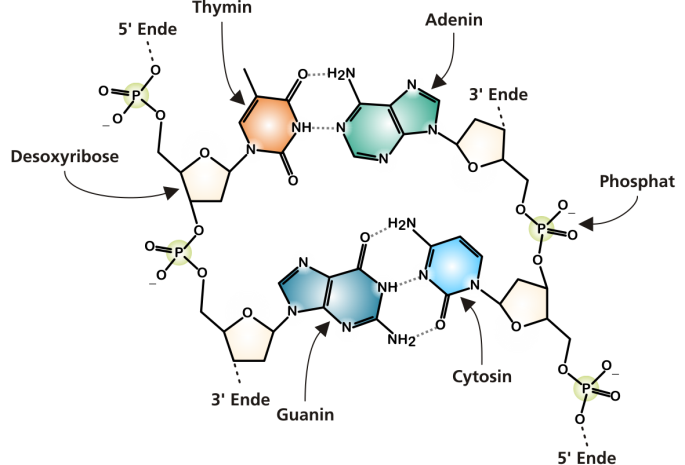
What is the length of human DNA containing \[6.6X{10^9}\] bp nitrogen bases/
A. 22nm
B. 0.22mm
C. 2.2m
D. 22m
Answer
558k+ views
Hint: The length of the DNA can be calculated by taking into consideration the total number of base pairs and the distance between two base pairs. We know that in one turn of DNA 10 base pairs are present and they are separated from each other by a distance of 0.34nm.
Complete answer:A DNA is a double helix structure, coiled in a right-handed fashion. It is a polymer of nucleotides that are formed by means of the nucleoside (sugars and nitrogenous bases) and the phosphate group. The sugar and the phosphate are said to form the backbone of the DNA while the ladder is formed by the nitrogenous bases which are the purines and the pyrimidines. The length of a DNA having one major and one minor groove is about 3.4 nm and it is said to have around 10 base pairs per turn. The distance between two consecutive base pairs of DNA is 0.34nm. The two strands of DNA are antiparallel to one another and form a double helix such that the purines and the pyrimidines bond with one another, to form a stable structure. If a DNA has \[6.6X{10^9}\]base pairs then the total length of the DNA can be calculated as follows –
Length of DNA = No. of base pairs X distance between two base pairs
\[\begin{array}{*{20}{l}}
{Length{\text{ }} = {\text{ }}\left( {6.6{\text{ }}X{\text{ }}{{10}^9}} \right){\text{ }}*{\text{ }}\left( {0.34{\text{ }}nm} \right)} \\
{Length{\text{ }} = {\text{ }}2.2{\text{ }}meters.}
\end{array}\]

Hence the correct option is (C), 2.2m.
Note:It should be noted that the DNA is very big and cannot be present as it is inside the nucleus and hence it is said to be associated with histone proteins so that the eukaryotic DNA is packed inside the nucleus. These proteins form a nucleosome, having a histone octamer around which the DNA is coiled. It forms a bead on the string model.
Complete answer:A DNA is a double helix structure, coiled in a right-handed fashion. It is a polymer of nucleotides that are formed by means of the nucleoside (sugars and nitrogenous bases) and the phosphate group. The sugar and the phosphate are said to form the backbone of the DNA while the ladder is formed by the nitrogenous bases which are the purines and the pyrimidines. The length of a DNA having one major and one minor groove is about 3.4 nm and it is said to have around 10 base pairs per turn. The distance between two consecutive base pairs of DNA is 0.34nm. The two strands of DNA are antiparallel to one another and form a double helix such that the purines and the pyrimidines bond with one another, to form a stable structure. If a DNA has \[6.6X{10^9}\]base pairs then the total length of the DNA can be calculated as follows –
Length of DNA = No. of base pairs X distance between two base pairs
\[\begin{array}{*{20}{l}}
{Length{\text{ }} = {\text{ }}\left( {6.6{\text{ }}X{\text{ }}{{10}^9}} \right){\text{ }}*{\text{ }}\left( {0.34{\text{ }}nm} \right)} \\
{Length{\text{ }} = {\text{ }}2.2{\text{ }}meters.}
\end{array}\]

Hence the correct option is (C), 2.2m.
Note:It should be noted that the DNA is very big and cannot be present as it is inside the nucleus and hence it is said to be associated with histone proteins so that the eukaryotic DNA is packed inside the nucleus. These proteins form a nucleosome, having a histone octamer around which the DNA is coiled. It forms a bead on the string model.
Recently Updated Pages
The number of solutions in x in 02pi for which sqrt class 12 maths CBSE

Write any two methods of preparation of phenol Give class 12 chemistry CBSE

Differentiate between action potential and resting class 12 biology CBSE

Two plane mirrors arranged at right angles to each class 12 physics CBSE

Which of the following molecules is are chiral A I class 12 chemistry CBSE

Name different types of neurons and give one function class 12 biology CBSE

Trending doubts
Which are the Top 10 Largest Countries of the World?

What are the major means of transport Explain each class 12 social science CBSE

Draw a labelled sketch of the human eye class 12 physics CBSE

Differentiate between insitu conservation and exsitu class 12 biology CBSE

The computer jargonwwww stands for Aworld wide web class 12 physics CBSE

State the principle of an ac generator and explain class 12 physics CBSE




